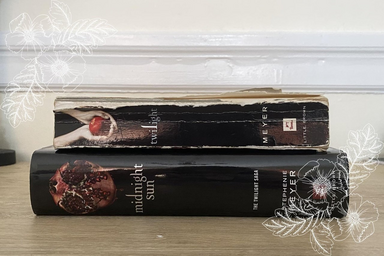If you haven’t finished Midnight Sun yet, there are potential spoilers ahead!
When the first twelve chapters of Midnight Sun leaked roughly 10 years ago, author Stephenie Meyer left them up on her website for all to access, leaving the fate of the complete project unclear. Since then, Twilight fans were resigned to believe we’d never get the rest of the story, but a whopping fifteen years after the release of the very first novel in The Twilight Saga, Edward’s version of events finally hit the shelves. Upon finishing it, Midnight Sun has lingered in my thoughts, allowing me to conclude that we readers, from the beginning, should have been introduced to the events of Twilight through Edward’s point of view instead of Bella’s, and here are five reasons why.
1. It’s Twilight with a 2020 lens
It’s no secret that Edward Cullen has received criticism for being hyper-protective of Bella, to the point where it comes across as misogynistic. After all, he refuses to accept Bella can take care of herself, and denies turning her into his equal – a vampire! But in Midnight Sun, there are frequent snippets in which Edward reflects on the importance of Bella’s free will and her agency, and at the core of it all, he wants what she wants for herself. The major caveat to this is her desire to become a vampire, which Edward refuses – but he makes it clear that his reasons stem from not wanting her to be a monster – the way he sees himself – rather than not wanting her to be his equal; in his eyes, she already is. Whether or not Stephenie Meyer took note of these criticisms from Twilight and intentionally made these adjustments to Midnight Sun we may never know, but regardless, I’m all for a feminist vampire boyfriend!
2. It’s darker, and I love it
Rather than reading from the perspective of an innocent, wide-eyed teenage girl who believes she is experiencing true love with an “Adonis,” we’re getting a glimpse into the mind of a tortured, lonely and severely depressed (which honestly seems like an understatement) vampire who is grappling with self-hatred for what he is. The darker tone of Midnight Sun adds a dimension to Twilight that wasn’t accessible to readers through Bella’s point of view.
3. It’s like a deep dive into Edward’s ability to read minds
Let’s be real, if you aren’t intrigued by seeing Edward’s vampire talent in action, gtfo. At times, it was fun to hear the thoughts of everyone surrounding Bella, especially the thoughts of her classmates. As a whole, understanding how his mind-reading works makes it easier to understand his character, and why he struggles with his inability to read Bella’s mind, a major plot point that contributes to his being drawn to her in the first place.
4. We understand the Cullens a whole lot more
Edward’s ability to read minds allows readers to gain a deeper insight into the personal histories of the Cullen family members. From what we saw in Twilight, for example, Rosalie is cold and distant towards Bella. Like Bella, we accepted that attitude as mere dislike for her, without knowing why. In Midnight Sun, however, Edward’s mind-reading gives us access to why Rosalie is the way she is; her yearning for a human life is a prominent part of her character that we don’t get the chance to understand in Twilight. Where Twilight paints her as vain, spoiled and haughty, Midnight Sun reveals her vulnerable side, adding a depth to her character we don’t see until much later in the series from Bella’s perspective.
5. Edward’s character development shines through
Edward’s complexity is highlighted so much in Midnight Sun. At the beginning of the novel he’s cynical and somber, bitter towards what he is and the monotony of his life. Upon meeting Bella, he becomes challenged as both a vampire and an individual, as she surprises him with her wit, kindness and desire to learn more about him. He’s disgusted, seeing no reason why she should even find him interesting, let alone have feelings for him. But, Bella stands her ground on multiple occasions, insisting her love for him is as valid as his is for her. While Edward continues to despise what he is at the end of the novel, he accepts Bella’s love, and by doing so, accepts that his decades of solitude were destined for her love, something he (at last!) deems worth being alive for.
Rather than introducing us to a love story through the eyes of a wholesome, teenage girl, Meyer should have taken the bold route in introducing us to the complicated and tormented mind of Edward Cullen first. I daresay Bella remains generally unchanged from the beginning to the end of The Twilight Saga, other than her newfound desire to share eternity with a vampire. Arguably, Edward is the one who experiences the most character development between the two; after all, he spent 108 years believing he would only know solitude and boredom. Bella changes Edward, and his love for her challenges him to be a better person and accept that, despite being a monster, he’s capable of love – and being loved in return.



